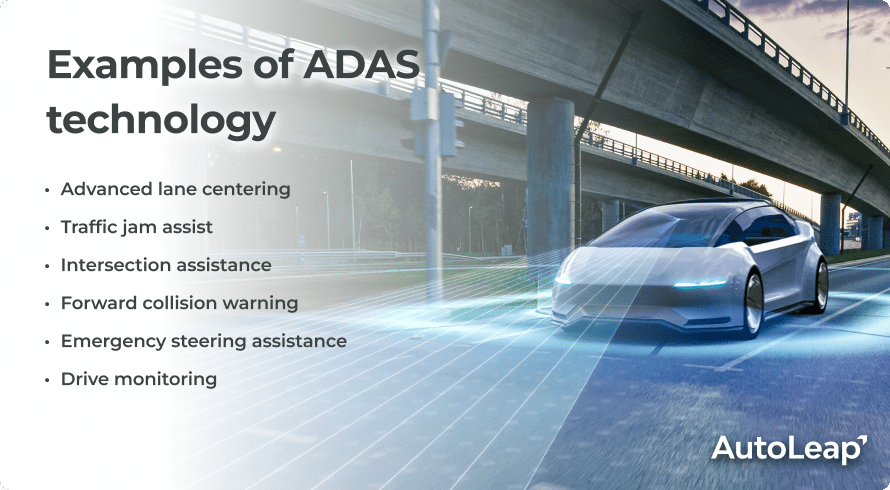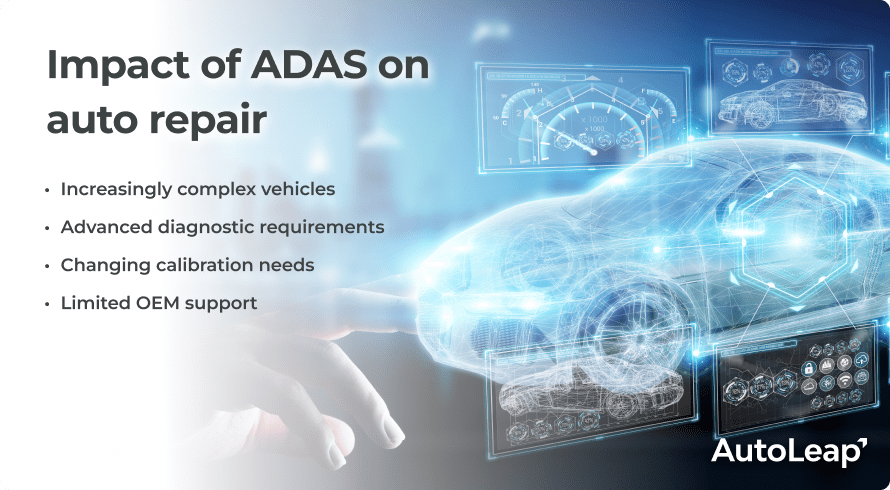Advanced Driver Assistance Systems (ADAS) have advanced the automotive industry by leaps and bounds. While this emerging tech is great for drivers, ADAS can pose particular challenges for auto repair shops.
In this blog post, we will cover the impact of ADAS on the vehicle repair industry. Let’s dive in!
Schedule a free demo today!

Boost your shop sales

Simplify shop management

Empower your technicians
The meteoric rise of ADAS
Did you know 83% of vehicles will feature some Advanced Driver Assistance Systems by 2030? That is incredible growth compared to 2019, when only 30% of cars featured ADAS technology. It demonstrates how quickly the automotive industry is developing.
The industry has undergone a revolution thanks to innovative technologies improving vehicle safety. However, the learning curve for auto repair may grow steeper the faster it develops. Dealing with ADAS technology poses a difficulty for the repair sector.
In a study of more than 3,000 vehicle owners conducted by The Insurance Institute for Highway Safety, approximately half of the participants indicated their ADAS technology still had issues after shop repairs.
However, this is not a blanket statement by any means. When there are challenges, there are also opportunities to learn from and grow! First things first, let’s understand ADAS on a deeper level.
Understanding Advanced Driver Assistance Systems (ADAS)
Technologies used in Advanced Driver Assistance Systems help drivers with many vehicle operations. These features include lane departure warnings, automated emergency braking, and adaptive cruise control. Other features include blind-spot recognition and parking assistance.
ADAS uses sensors, cameras, radars, and other cutting-edge technologies to monitor the area around the vehicle. This technology helps identify potential hazards and prevent unexpected collisions.
The startling numbers on the development and effect of ADAS so far are as follows:
- Market growth: The rapid market acceleration of ADAS technology is undeniable. According to Grand View Research, the ADAS market is expected to reach over $66 billion by 2030. With projected figures like that, it’s clear that this emerging vehicle tech will become a mainstay consideration for auto repair shops and the specialized services they offer.
- Adoption rates: ADAS technology adoption has been constantly rising. IHS Automotive estimates that 30% or more of new cars sold worldwide in 2015 include ADAS characteristics. The analysis predicted that if ADAS technologies spread and become legally required, this percentage would nearly double to 100% by 2035.
- Impact on security: ADAS technology has improved road safety with encouraging outcomes. The National Highway Traffic Safety Administration (NHTSA) estimated that ADAS features could potentially prevent up to 28,000 crashes and 12,000 injuries annually in the United States.
- ADAS features: Several ADAS features are becoming more popular . Adaptive cruise control, lane departure warning, blind-spot detection, automatic emergency braking and rear view cameras are some of the most widely adopted ADAS technologies since 2015.
- Consumer awareness and demand: The demand for and knowledge of ADAS technologies among consumers has increased. The AAA Foundation for Traffic Safety found in a 2015 survey that 70% of American passengers and drivers wanted ADAS features in the next car they bought. Nearly half of the drivers who purchased a vehicle with ADAS features said the system prevented a collision, according to the survey.
» Want to prepare for emerging vehicle technology? Read our free eBook.
A look at the latest Advanced Driving Assistance Systems

Some of the most prominent Advanced Driving Assistance Systems include:
- Advanced lane centering: This is one of the most popular ADAS functions. Advanced lane centering can control steering to keep the vehicle centered within the lane. This system modifies the steering input while monitoring lane markings with sensors and cameras. It provides a more refined and precise lane-keeping experience.
- Traffic jam assist: The purpose of traffic jam assist is to reduce the strain of driving in high-activity areas. In stop-and-go traffic, the application combines adaptive cruise control and lane centering. These functions automatically adjust to the vehicle’s speed, acceleration, and steering. The system may bring the car to a complete stop if necessary, keep it at a safe distance from the car in front of it and keep it in the middle of its lane.
- Assistance at intersections: Intersection assistance systems use sensors and cameras to spot potential intersection hazards. By recognizing other vehicles, pedestrians, or cyclists approaching the crossing, they can warn drivers of oncoming traffic. This contributes to the prevention of collisions. When there is a chance of poor vision or if the driver is paying attention to other things, these devices are a great answer.
- Forward collision warning with pedestrian detection: This system improves on automatic emergency braking (AEB) by incorporating pedestrian detection. It can alert the driver when a pedestrian enters the car’s path using cameras, radar, or lidar sensors. The technology may automatically apply the brakes to avoid an accident if the driver doesn’t react.
- Emergency steering assistance: Emergency steering assistance helps the driver perform evasive maneuvers. This technology identifies potential collision hazards with the aid of sensors and cameras. The system may intervene or increase steering torque if it determines the driver’s response is insufficient.
- Driver monitoring and attention systems: These systems monitor the driver’s activities, level of attentiveness, and drowsiness to ensure safe driving. They observe the driver’s head position, other facial features, and eye movements using cameras and sensors. The system may examine these factors to spot indicators of inattention or fatigue and alert the driver as needed.
- Augmented reality head-up display: HUD systems incorporating augmented reality (AR) let drivers see vital information such as speed limits and driving instructions. This information displays on the windscreen, allowing drivers to access data while keeping their eyes on the road. Additionally, AR HUD can offer improved situational awareness and assistance in safe driving.
The impact of ADAS on auto repair services

Increasing complexity
ADAS systems have increased the complexity of vehicles. Repairing and maintaining these systems requires specialized skills, equipment and software. Technicians must keep up with the most recent education and certifications to diagnose and repair ADAS components.
Diagnostic difficulties
ADAS systems gather a ton of information from various cameras and sensors in the car. It becomes challenging to make sense of this information and pinpoint the root cause of a problem. Technicians need access to cutting-edge diagnostic tools and software to identify and resolve ADAS-related problems.
Calibration and recalibration
When ADAS components are fixed or changed, these processes are crucial. Proper calibration ensures the systems’ correctness and proper operation. Inadequate calibration can reduce the effectiveness of ADAS systems, causing risks.
Limited OEM support
Original Equipment Manufacturers (OEMs) usually hold the only diagnostic tools and information available for ADAS systems. This makes it challenging for independent repair shops to get these tools.
OEMs and independent repair shops must work together to close this gap. That way, they can guarantee secure and efficient maintenance of ADAS-equipped vehicles.
Challenges faced by auto repair technicians

Skills gap
No matter how fast we evolve, it’s hard to keep up with the rapid pace of technological advancements. This poses a challenge for experts in vehicle repair to specialize in the emerging ADAS systems.
Ongoing training and educational programs are crucial for technicians. These resources help them acquire the abilities and knowledge necessary to understand and work on these systems.
Investment in tools and equipment
New tech requires state-of-the-art diagnostic equipment, tools, and software. This specialized equipment is important for maintenance and repairs. It can be a costly investment, but a crucial one. Repair businesses should make room in their budget for such equipment to identify and fix ADAS components.
Liability issues
ADAS systems are responsible for human safety on the road. Nothing can be left to chance when it comes to their repair. To ensure accurate repairs, calibration, and recalibration, technicians need specialized training.
They also need awareness of the precise processes and rules. Not being on top of your game can lead to accidents. That can cause legal consequences and damage your shop’s reputation.
Opportunities with ADAS
This is not to say that there are only challenges ahead. Let’s explore the different opportunities that ADAS creates for the auto repair industry.
Collaboration and partnerships
OEMs, independent repairers, and third-party service providers should work together. Collaboration can close the access gap to ADAS information, tools, and resources. Partnerships can provide doors for knowledge exchange, training initiatives, and support for shops.
Data-driven services
Shops can leverage the data produced by ADAS to offer preventative maintenance and repair services. Repair facilities can use this data to undertake predictive maintenance. They can also give early problem detection and enhance vehicle performance. These services increase customer satisfaction.
ADAS upgrades and retrofits
There is a market for replacing outdated ADAS technology in older vehicles with more modern ones. Or modify current systems due to the ongoing growth of ADAS technologies.
Auto repair shops can take advantage of this market by providing retrofitting services. These services can improve the security and convenience of older models.
» Looking to transform your shop? Discover how AutoLeap can help.
Closing thoughts
We recognize that ADAS is increasingly complex and requires specialized training and equipment. But this technology also presents an opportunity for shops to offer differentiating services.
Check out our emerging tech eBook to prepare your shop for ADAS technology and create a definitive edge over shops in your area.
FAQs
What is the function of ADAS in a car?
Human error is the primary factor in almost all auto accidents. It’s potential risks that Advanced Driver Assistance Systems (ADAS) can help drivers avoid.








